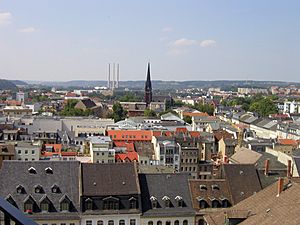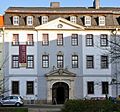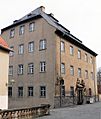Gera facts for kids
Quick facts for kids
Gera
|
|||
|---|---|---|---|

A view of Gera.
|
|||
|
|||
| Country | Germany | ||
| State | Thuringia | ||
| District | Urban district | ||
| Founded | 995 | ||
| Elevation | 205 m (673 ft) | ||
| Population
(2011-12-31)
|
|||
| • Total | 98,762 | ||
| Time zone | CET/CEST (UTC+1/+2) | ||
| Postal codes |
07457-07557
|
||
| Dialling codes | 0365, 036695 | ||
| Vehicle registration | G | ||
| Website | www.gera.de | ||
Gera is a city located in the eastern part of Germany. It is found in the state of Thuringia.
Gera is home to about 100,000 people. It is known for its interesting history and beautiful sights.
Contents
A Look Back: Gera's History
At first, "Gera" was not the name of a town. It was the name of a whole region. This region was first mentioned in a document in the year 995.
Just four years later, in 999, the Holy Roman Emperor Otto III gave this region to his sister. Her name was Adelheid, and she was an abbess (a leader of a group of nuns) in Quedlinburg.
How Gera Became a Town
A town named Gera grew in the middle of this region. In 1237, another document officially mentioned the town of Gera for the first time.
In this town, the abbesses of Quedlinburg had special officials. These officials were called Vögte. They were the ancestors of the counts and princes of Reuß. These rulers governed Gera for many years, all the way until 1918.
Important Times in Gera
In the early modern period, Gera became famous for making textiles (cloth). The town faced big fires that destroyed much of it. These fires happened in 1686 and again in 1780.
In 1806, the famous French leader Napoleon visited Gera. This was just before a major battle called the Battle of Jena.
Growing into an Industrial City
During the 19th century, Gera grew into an important city for industry. Before this time, Gera was quite small. But by the year 1900, it had about 45,000 people living there.
In 1920, Thuringia was created as a state within the Weimar Republic. Gera was the largest city in this new state. This was because Erfurt was not yet part of Thuringia.
World War II and Beyond
Towards the end of World War II, some parts of Gera were damaged by bombs. For example, the Osterstein Castle was destroyed.
After World War II, Gera was in the Soviet Occupation Zone. Later, it became part of the German Democratic Republic (GDR). From 1952 to 1990, Gera was the capital of the Gera District (Bezirk Gera) in the GDR.
Since the German Reunification in 1990, Gera has been part of the Free State of Thuringia. This state is in the Federal Republic of Germany.
People Living in Gera
Since 1959, Gera has had more than 100,000 people living in it. The most people ever living in Gera was 134,834 in 1988.
After the German Reunification, the number of people living in Gera started to get smaller. Now, fewer people live in Gera than in Jena. This means Gera is only the third-biggest city in Thuringia. On December 31, 2008, there were 100,643 people living in Gera.
Places to See in Gera
Gera has many interesting places to visit:
- The Market Square is a central spot. It has the City Hall (Rathaus) from 1575. You can also see the Simson Fountain (Simsonbrunnen) from 1686 and the City Pharmacy (Stadtapotheke) from around 1600.
- The Geraer Höhler are old cellars. They are located under houses in the city center. In the 1700s, people used them to store their beer.
- The Theatre was built in 1902. It is a beautiful building where plays and shows are performed.
- The Orangerie was built in 1748. Today, it is an art gallery in Gera.
- St. Salvator's Church (Salvatorkirche) was built in 1717. It is a great example of Baroque style architecture.
- St. John's Church (Johanniskirche) was built in 1884. It shows the Gothic Revival architecture style.
- St. Mary's Church (Marienkirche) is in the Untermhaus area. It is near the birth house of famous artist Otto Dix.
- The Hofwiesenpark is a new park. A big garden show called the Bundesgartenschau was held there in 2007.
Cities Partnered with Gera
Gera has twelve twin towns, also called sister cities. These are cities that have a special partnership with Gera. Eleven of these partner cities are in Europe.
|
|
Famous People from Gera
Many well-known people were born in Gera:
- Otto Dix (1891–1969) was a famous painter.
- Georg Buschner (1925–2007) was the head coach of the East Germany national football team.
- Max Frankel (born 1930) was an executive editor for the New York Times and won a Pulitzer Prize.
- Marlies Göhr (born 1958) is a well-known athlete.
- Olaf Ludwig (born 1960) is a famous cyclist.
- Wolfgang Tiefensee (born 1955) is a politician.
- Heike Drechsler (born 1964) is also a famous athlete.
Images for kids
See also
 In Spanish: Gera para niños
In Spanish: Gera para niños







































